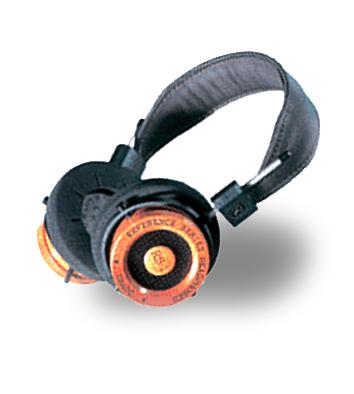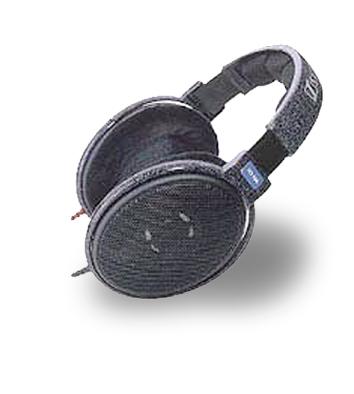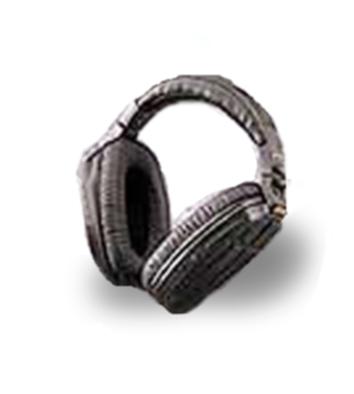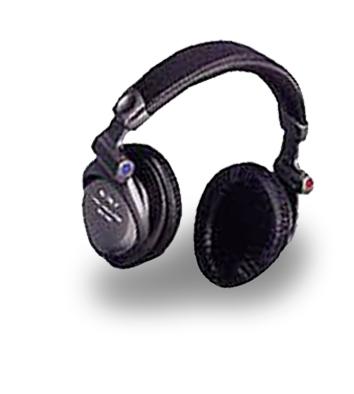Most people in the market for a portable CD or MP3 player are faced with a mind-numbing array of choices, styles and features in a wide range of prices. The irony is that most all of these players ship with the same kind of cheap earbud-style headphones that render music the same, whether you've purchased a US$30 player or a US$300 one. Any audiophile will tell you that, as with component stereo equipment, it's best to purchase a less expensive player and use the money you save towards a decent set of speakers. Doing so buys more than improved sound, it can allow you to hear a part of your music collection you may have never heard before. For anyone who might be in the market for a set of premium-quality headphones or anyone interested in the differences between them -- here are five of the most popular models that range in price from US$100 to US$1,000.
Sony MDR-V6

PHOTO COURTESY OF THE MANUFACTURERS
Retail price: US$110

PHOTO COURTESY OF THE MANUFACTURERS
This model represents the entry-level of premium-quality headphones. While not the inventors of headphones, Sony is largely responsible for their popularization after the company released its first Walkman TPS-L2 in 1979.

PHOTO COURTESY OF THE MANUFACTURERS
That device's popularity caused several audio-equipment manufacturers -- including Sony -- to research and develop better headphones.

PHOTO COURTESY OF THE MANUFACTURERS
The MDR-V6s are of a closed design, so called because they are made to block out external noise in an attempt to deliver clearer sound quality. An additional and often important benefit to a closed design is that sound leakage (how much sound the person sitting next to you can hear) is minimal.
The headphones deliver excellent midrange sound and better bass than most other models, but higher frequencies are often shallow and tinny. Far from being comfortable, the MDR-V6s have a vinyl pad that makes you think more about how much your ears are sweating than about the music you're listening to. Just as annoying, the sponge padding is too soft, allowing the metal driver covers to rest on your ears.

PHOTO COURTESY OF THE MANUFACTURERS
Sony MDR-V700DJ
Retail price: US$150
Buy Sony's V700DJs and you'll need to learn sign language. They are designed for DJs who have to mix in very loud clubs. They shut out external noise almost completely and their wide frequency response -- particularly in the low range -- means you'll be reaching to turn the bass down rather than turn it up as you might do with most other headphone models.
The V700DJ's leather-covered earpads are considerably more comfortable than the MDR-V6's and the harder sponge padding inside rests more comfortably on the ear. I was not impressed, however, with the plastic swivels that connect the speaker cups to the headband -- odd since Sony was wise enough to plate the pick-ups in gold. After further research, I learned that a lot of people whose V700DJs had broken after years of use remarkably bought the exact same model a second and third time.
Sennheiser HD-600
Retail price: US$450
From here we make not only a big leap in price, but a dramatic leap in sound quality. The Sennheiser HD-600 is one of the less-expensive of the tudio models touted by the world's audiophiles (read: people with a lot of money and not many friends). And although a pair of HD-600s will only set you back US$450, their quality actually exceeds that of more expensive models. This is not a coincidence as they are among the most expensive made by the company that has won plaudits for the quality of their products and captured a huge slice of the audio market.
My personal complaint with the HD-600s is that the leads attach individually to each side, instead of to just one side as is the case with most recent-model headphones. While the headphones are of a closed design, the ventilated backs of the speaker cans allow for quite a bit of leakage, something that will undoubtedly be more annoying to anyone nearby than to the listener.
Grado RS1
Retail price: US$650
While Grado does not enjoy a large share of the audio market, it does enjoy significant praise. This is mostly do to its unique mahogany-crafted headphones that are made using a long wood-curing process similar to that used to make acoustic guitars. The difference is noticeable. Basses are more resonant than in most other models despite the fact that they are of an open-air design. Because of this, however, they're not very good for keeping the music only in the listener's ear -- anyone standing nearby can easily be annoyed.
Having gone to great lengths to use a high-quality wood in their manufacturing process, it's a pity that Grado didn't give as much attention to the earpad in the RS1, their top-of-the-line model. Instead, it's employed an uncovered foam pad that is rather scratchy and bothersome, albeit not as sweaty as leather or vinyl-covered pads.
Koss ESP-950
Retail price: US$999
Here are some of the most expensive headphones you can buy. Koss' market for the ESP-950 includes radio astronomers as well as music and film professionals. The reason for this is the model's frequency range: 8 to 35,000Hz. This is more than the average listener needs considering that the human ear can only detect sounds within the 20 to 20,000Hz range. If you ever have the opportunity to test-drive them, you'll be floored.
In addition to the quality of the cans themselves, Koss has included a headphone amplifier that makes up for weaknesses in the equipment playing the music. The result is dramatic: Each instrument comes alive in your head as if it had its own dedicated speaker within each earpiece.
At US$1,000, the ESP-950s are a serious investment, but the price is mitigated by a no-questions-asked lifetime warranty. One last word on high-end audio equipment: don't look for it in retail stores. Online trading sites like eBay are crowded with gear that music professionals are looking to get rid of because they've moved on to something better, but the quality of what they're selling is often as good as the day it was manufactured.
Good headphones, like good floor speakers, sound better as they get older.

June 23 to June 29 After capturing the walled city of Hsinchu on June 22, 1895, the Japanese hoped to quickly push south and seize control of Taiwan’s entire west coast — but their advance was stalled for more than a month. Not only did local Hakka fighters continue to cause them headaches, resistance forces even attempted to retake the city three times. “We had planned to occupy Anping (Tainan) and Takao (Kaohsiung) as soon as possible, but ever since we took Hsinchu, nearby bandits proclaiming to be ‘righteous people’ (義民) have been destroying train tracks and electrical cables, and gathering in villages

Swooping low over the banks of a Nile River tributary, an aid flight run by retired American military officers released a stream of food-stuffed sacks over a town emptied by fighting in South Sudan, a country wracked by conflict. Last week’s air drop was the latest in a controversial development — private contracting firms led by former US intelligence officers and military veterans delivering aid to some of the world’s deadliest conflict zones, in operations organized with governments that are combatants in the conflicts. The moves are roiling the global aid community, which warns of a more militarized, politicized and profit-seeking trend

The wide-screen spectacle of Formula One gets a gleaming, rip-roaring workout in Joseph Kosinski’s F1, a fine-tuned machine of a movie that, in its most riveting racing scenes, approaches a kind of high-speed splendor. Kosinski, who last endeavored to put moviegoers in the seat of a fighter jet in Top Gun: Maverick, has moved to the open cockpits of Formula One with much the same affection, if not outright need, for speed. A lot of the same team is back. Jerry Bruckheimer produces. Ehren Kruger, a co-writer on Maverick, takes sole credit here. Hans Zimmer, a co-composer previously, supplies the thumping

Dr. Y. Tony Yang, Associate Dean of Health Policy and Population Science at George Washington University, argued last week in a piece for the Taipei Times about former president Ma Ying-jeou (馬英九) leading a student delegation to the People’s Republic of China (PRC) that, “The real question is not whether Ma’s visit helps or hurts Taiwan — it is why Taiwan lacks a sophisticated, multi-track approach to one of the most complex geopolitical relationships in the world” (“Ma’s Visit, DPP’s Blind Spot,” June 18, page 8). Yang contends that the Democratic Progressive Party (DPP) has a blind spot: “By treating any